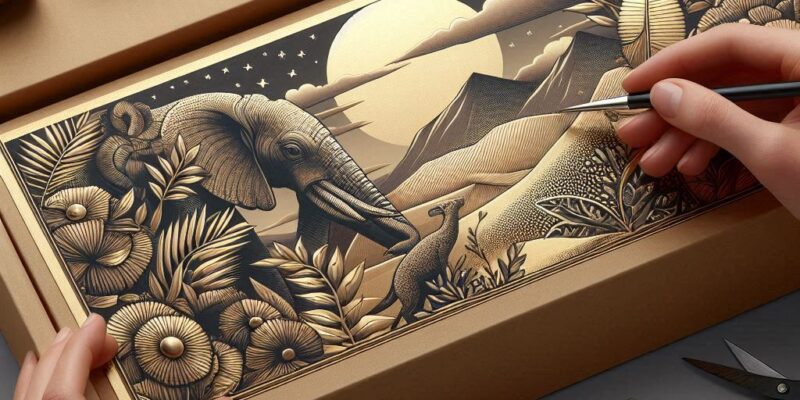Creating effective packaging is an art and a science. It requires careful planning, creativity, and strategic thinking to ensure that your packaging not only protects the product but also attracts customers and communicates your brand’s values. Here’s a step-by-step guide to help you navigate the packaging designs process from concept to shelf.
1. Understand Your Brand and Product 🧠
Before you start sketching designs, it’s crucial to understand your product and brand identity.
- Brand Values: What does your brand stand for? Are you focusing on sustainability, luxury, or affordability?
- Target Audience: Who is your target market? Are they eco-conscious millennials, busy professionals, or luxury-seeking consumers?
- Product Requirements: Does your product need extra protection? For example, fragile items might require padded packaging or moisture-resistant materials.
Tip: A clear brand vision helps define the visual and emotional tone of the packaging design.
2. Market Research & Competitor Analysis 🔍
Understanding your competition and industry trends is essential for standing out on the shelf.
- Study Competitors: Look at competitors’ packaging. What works? What doesn’t? Identify gaps that your design can fill.
- Consumer Preferences: What do consumers in your target demographic care about? Are they more focused on aesthetics, functionality, or environmental impact?
- Packaging Innovations: Explore packaging trends (e.g., minimalism, interactive designs, smart packaging, or sustainable options) to keep your design fresh and relevant.
Tip: Researching successful brands will inspire unique ideas for your packaging while avoiding cliches or oversaturated trends.
3. Define the Packaging Brief ✏️
A well-defined packaging brief ensures that the design process stays on track and aligns with your business goals. This includes:
- Size & Shape: The dimensions of the package will depend on the product and transportation needs.
- Materials: Choose packaging materials that protect the product while staying true to your sustainability or luxury goals.
- Budget: Define your packaging budget to make informed decisions without compromising on quality.
- Brand Elements: List brand colors, typography, and logos to maintain consistency.
Tip: Collaborate with your production team to understand technical limitations and requirements for materials and manufacturing processes.
4. Sketching & Concept Design 🎨
Now comes the creative phase. Designers begin to brainstorm and sketch several packaging concepts. This phase usually involves:
- Multiple Concepts: Create different packaging options that vary in design, layout, and material choice.
- Prototyping: Physical or digital mockups help visualize the packaging in 3D form.
- Incorporating Feedback: Collect feedback from your team, stakeholders, and target audience to refine the designs.
Tip: Don’t settle for the first design. Experiment with different elements until you find a solution that works best for your product.
5. Finalizing Design Details ✨
Once you have your best concept, it’s time to refine the details and prepare for production.
- Typography: Choose fonts that are readable and aligned with your brand identity.
- Color Palette: Ensure your colors are consistent with your brand and product message.
- Graphic Design Elements: Add patterns, textures, and illustrations that make your packaging visually appealing.
- Labeling & Compliance: Ensure all legal requirements are met (e.g., nutrition facts, barcodes, safety warnings, or certifications).
Tip: Double-check readability, especially for small text on packaging. Keep it legible at different sizes.
6. Test, Review & Refine 🔄
Once the design is ready, test it with your target audience. This feedback loop is crucial to ensure that the packaging not only looks good but works well in real-world situations.
- Market Testing: Conduct consumer testing to gauge reactions to the design.
- Functionality Tests: Ensure that the packaging protects the product during transit and is easy to open, store, and dispose of.
- Refinement: Based on testing results, make any necessary design adjustments.
Tip: Even small tweaks can make a big difference in how your packaging performs on shelves.
7. Production & Manufacturing 🏭
Once the design is approved, move into production. This step involves:
- Choosing the Manufacturer: Partner with a reliable packaging manufacturer who can meet your quality standards.
- Material Sourcing: Ensure the materials are sourced as per your design specifications.
- Proofing & Sampling: Request prototypes and samples before mass production to ensure the final product matches your expectations.
- Quality Control: Implement quality checks to avoid production errors.
Tip: Build strong communication with the production team to ensure everything stays on schedule and within budget.
8. Distribution & Retail Readiness 📦
Once your packaging is ready, ensure it’s prepared for retail or e-commerce success.
- Retail Displays: Design packaging that will stand out on retail shelves or within online listings.
- Shipping Considerations: Ensure the packaging is optimized for shipping, including safety, durability, and cost-effectiveness.
- Shelf Impact: Consider how your product will look next to competitors on the shelf, and whether additional promotional materials or point-of-sale displays are needed.
Tip: Ensure the packaging is easy to transport without compromising on safety.
9. Post-Launch Feedback and Iteration 🔄
Once your product hits the shelves, it’s important to continue collecting feedback.
- Customer Insights: Analyze customer feedback about your packaging to identify pain points or areas for improvement.
- Performance Tracking: Monitor how your packaging design affects sales, brand awareness, and customer loyalty.
- Iterative Updates: Be open to revising your packaging design over time based on new trends, consumer preferences, or product changes.
Tip: Continuous improvement will help you stay competitive and relevant in an ever-evolving market.
Conclusion
The packaging design process is complex, but by following this step-by-step guide, you can create packaging that stands out, strengthens your brand, and enhances the customer experience. From concept to shelf, remember that your packaging is a reflection of your product and brand. In 2024, a great design is not just about looking good — it’s about creating a story, evoking emotions, and building long-term relationships with your customers.
